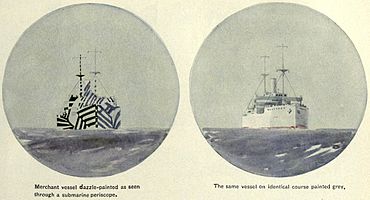Having had a career in the military, I know something about camouflage. A common opinion is good camouflage is supposed to make you disappear into the background (which has led to a lot of jokes, particularly about stealth technology). Actually all camouflage has to do is make a recognizable shape unrecognizable, if only for a few seconds. That’s the idea behind zebra stripes; charge into the herd and you have to hesitate to see who is running where.
One of the best examples of this in the human world was called “dazzle camouflage.” It originated in World War I, inspired by the art world.
Artist Norman Wilkinson preferred to paint realistic naval battles and landscapes; he was no fan of the cubists. But as a British naval officer patrolling the English Channel for mines in 1917, he realized how contrasting colors and geometric patterns could cause confusion among German submarine commanders.
Wilkinson preferred to paint realistic naval battles and landscapes; he was no fan of the cubists. But as a British naval officer patrolling the English Channel for mines in 1917, he realized how contrasting colors and geometric patterns could cause confusion among German submarine commanders.
Submarines normally must make quick decisions (usually under 30 seconds to minimize the chances of being spotted) through a periscope of a ship’s heading, range and speed to predict where there targets are going in order to hit them. Bright patterns certainly complicated those decisions. Curves pointed on the stern created false bow waves, bold geometric patterns on the hull made the bow and stern appear similar, and shapes on the smoke stacks confused any observer to which way a ship was headed.
As bizarre as this sounds, it did seem to work, ultimately leading to 4000 ships painted in dazzle camouflage. Each ship sported a unique pattern. Statistically, these ships were about 11 percent less likely to be hit with torpedoes, and the technique continued well into World War II. However, the debate about its effectiveness was on-going, and with technological advances in range-finding and aircraft spotting (remember it actually increased visibility), its use decreased until it was discontinued after 1945.
But it still works for zebras.
Photo: Artist’s concept of the periscope view of a ship with and without dazzle camouflage (Google Images)
https://en.wikipedia.org/wiki/Dazzle_camouflage
http://www.ozy.com/flashback/how-the-british-fooled-the-germans-with-cubist-paintings/81047?
